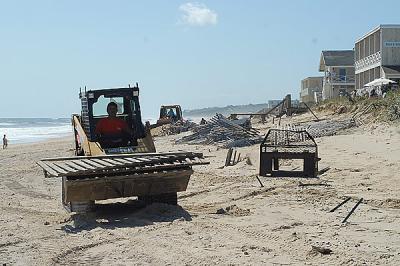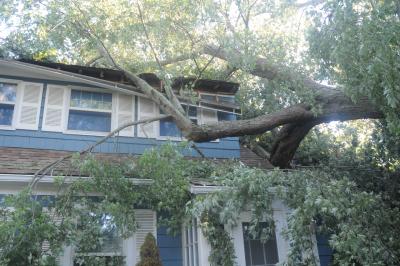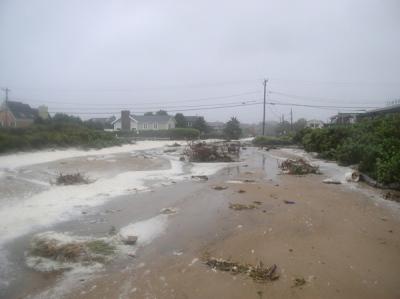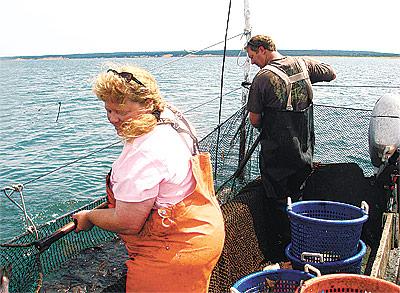Beaches Pummeled, Spared Worst
Beaches Pummeled, Spared Worst

Tropical Storm Irene was the final straw for at least one oceanfront property owner whose house is just west of Georgica Beach. The effort to protect the property in the future promises to be controversial.
In Montauk on Tuesday, the Keith Grimes Construction company was hired by the owners of the Royal Atlantic motel to recreate a protective dune that was virtually melted by Irene’s storm surge on Sunday.
__
Click for Slideshow
__
Other sand was trucked to the beach in front of Montauk’s motel row by Pat Bistrian Materials to rebuild dunes in front of a few of other oceanfront motels. Although the beach was pummeled there, the destruction was nothing like the damage caused by Tropical Storm Earl in early September last year.
The work was authorized by Larry Penny, the town’s director of natural resources, who was reportedly given the authority to make the decision by an agent of the State Department of Environmental Conservation, who asked that the work be documented with photographs.
At the job on Tuesday afternoon, Mr. Grimes spoke about Irene and about his vision of how downtown Montauk can be protected from future storms. He said the ideal green scenarios that have been talked about, “retreat,” that is, moving vulnerable buildings back from the beach, or mining sand continuously from offshore, were far too costly and impractical. He said he had talked to motel owners about driving steel sheathing directly seaward of their buildings parallel to the beach as a last defense with dunes and dune grass in front of the steel.
“What gets me is, it won’t hurt the beach and we have the technology,” he said. Mr. Grimes warned that abandoning the beachfront posed other risks, not the least of which was damage to a water main just north of the beach area.
Before Irene arrived on Sunday, owners of a house at Georgica Beach placed sand bags in front of their beach access to block storm surge. “The bags are on their property,” said Larry Cantwell, the East Hampton Village administrator. In question, however, is the fencing placed on the beach in front of the sand bags. The fencing was the property owner’s claim to the beach, Mr. Cantwell said.
Mr. Cantwell said the owners reasoned that because the metes and bounds of their land extended, before it eroded, to the spot marked by the seaward end of their fence, the beach was now theirs. According to a man who spoke to a spokesman for the property owner, the plan was to close off the beach property in question with a hard structure. If that is true, the plan is likely to face strong opposition from the East Hampton Town Trustees, Diane McNally, the trustees’ presiding officer, said yesterday.
Surfers have posted signs in protest of the fence, one saying, “Su playa es mi playa” (Your beach is my beach).
Ms. McNally reported that Lazy Point, a community fronting Gardiner’s Bay and built upon trustee-owned land, was not damaged.
All day Tuesday, Mr. Penny assessed erosion damage throughout town. In many places his department had measured beaches in order to have a comparison after Irene passed. In the interest of safety, all of the oceanfront road ends were closed by the town. Although there were complaints from people who wanted to observe the fury, the order was apparently a good call, as most beach road ends were flooded by storm surge especially during an extra high tide Sunday morning. Fortunately, because waves and wind struck Montauk’s beaches with a direct blow from the south, beaches avoided the scouring caused when waves and current cut east to west, as happened during Earl.
“Even so, Montauk on the ocean side lost 50 percent of its sand,” Mr. Penny said. The Ditch Plain area also lost sections of dune and hardpan, including a section that had held an old Pontiac since the 1940s, by the look of it. Tony Velar, a surfer, discovered the car’s grille, hood, and hood ornament where they had fallen, intact, from an eroded dune. Gin Beach on the north side of Montauk lost nothing, and the vulnerable Soundview community, also on Block Island Sound, looked none the worse for wear, Mr. Penny said.
Soundview was spared because “the power [of the storm] was coming in from the south,” Mr. Penny said. Nonetheless, the beach just north of the town parking lot at Gosman’s Restaurant lost a good deal of sand, as it usually does after a blow.
On the oceanside, half the beach in front of the Benson Preserve on Old Montauk Highway was taken away by storm waves. The beach house in front of Gurney’s Inn was damaged. Mr. Penny said Gurney’s was given an emergency permit to buttress its beach with sand.
Georgica Beach in East Hampton Village took the worst hit in the township. Dunes were sheared off to make precipitous cliffs of sand. “It’s severe,” Mr. Cantwell said of the beach erosion in the village, “but the road end at Georgica has been threatened before, and it’s come back.”
Montaukers are not prone to looking a gift horse in the mouth: The horse in question this time was Irene and the gift took the form of hundreds of surf clams dredged from the bottom offshore by the storm’s huge swells, dragged ashore by her violent storm surge, and left broken on the beach just east of Ditch Plain.
People who had come down to gauge the extent of Irene’s wrath included fishermen who saw the broken clams as a serendipitous supply of bait for sea bass and, later in the season, cod.
There was general agreement that Montauk, in fact all of East Hampton, had dodged a bullet. East Hampton Town received only two inches of rain, and although winds gusted over 70 miles per hour at times, they came from the south during the height of the storm and west as the storm passed.
At the height of the storm, the ocean flowed into the Ditch Plain community through the town parking lot at the East Deck Motel. The front row of trailer homes at the Montauk Shores Condominium complex received some flooding. Its stone revetment was not overtopped, but was spared that fate by only a few feet. Had there been more rain, the flooding might have been extreme.
Montauk’s commercial fishing fleet was also spared the fierce north wind and accompanying tidal surge that so often occur when a retreating hurricane’s counter-clockwise rotation aims its full force through the harbor mouth.
It was clear from the preparations that citizens and officials alike took Irene seriously. Shops were boarded up, but many remained open on Saturday and even Sunday during the storm. The Montauk I.G.A. kept its doors open despite the billows of ocean spray that flew over the dunes to greet shoppers.
Reached Monday morning, East Hampton Town Councilwoman Theresa Quigley said whether the town had in fact dodged a bullet was “a function of perspective,” but in general she said that it could have been worse. “Nobody died or was harmed that I know of except for losing electric.”
“I drove all over town on Sunday. There were big trees down all over. It looks like the highway department did an incredible job. I think they must have worked all night clearing trees.”
If missing a really good surf session can be considered an injury, then dozens of disappointed surfers were injured on the afternoon before the storm when Montauk Point State Park was closed, cutting them off from excellent waves at Turtle Cove and off the Lighthouse itself.






